Understanding the fundamentals of fabric will help you to design and sew garments confidently. The majority of our clothing, homewares, shoes, and bags are made from fabric, which can be silky or rough, thin or thick, woven or knitted. This beginner’s guide to types of fabrics and materials with names and pictures will help you make informed fabric decisions when sewing.
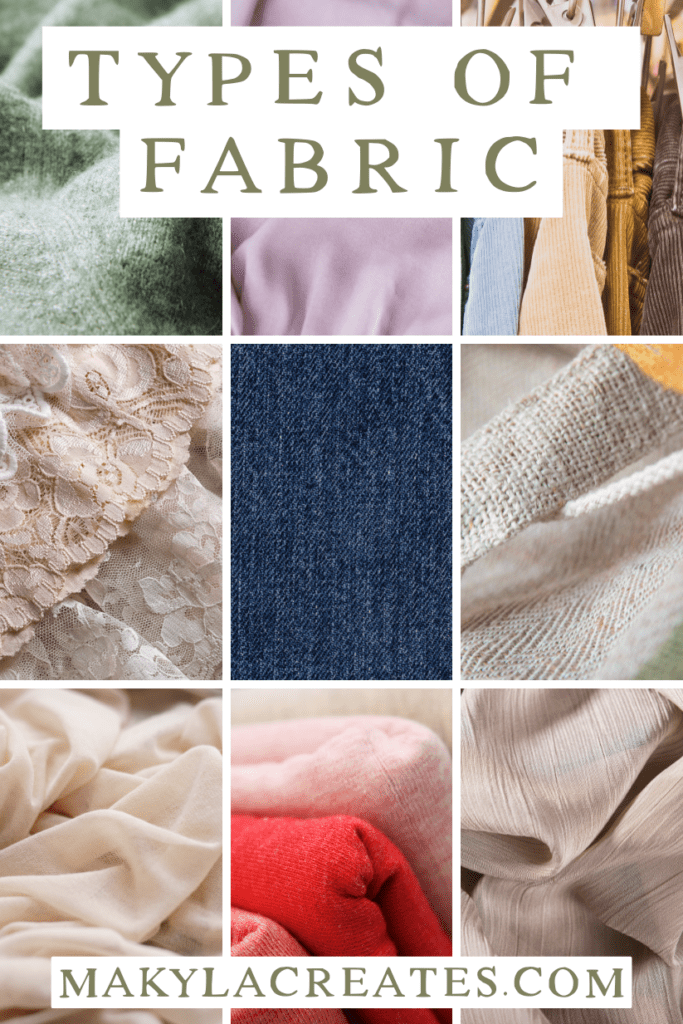
It can suck when you finish sewing a garment and it just doesn’t sit right. This is common, and I’m also a victim of this disappointment. Learning about fabric properties and how they drape, stretch, and wash can make a difference.
What are Textiles?
Textiles are fibres or filaments spun into a yarn and then woven or knit into fabrics. These fibres can come from natural or synthetic sources. The fibres are twisted together to create long, intertwining lengths of yarn. These yarns are then made into different fabrics like denim, silk, cotton poplin or rayon, to name a few.
According to a report written by Textile Exchange, fibre production has almost doubled in the last 20 years, from 58 million tonnes in 2010 to 109 million tonnes in 2020.
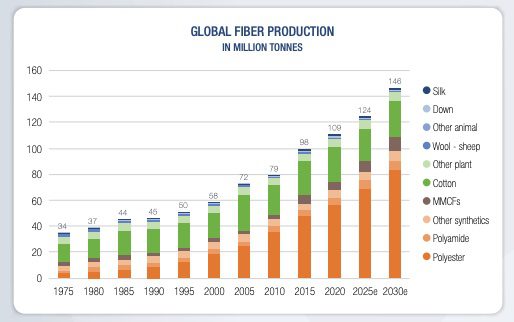
Natural vs Synthetic Fabrics
First, let’s look at where the raw fabric fibres come from. Natural fabrics like linen and wool come from natural sources like plants or animals. Synthetic materials like polyester or nylon come from oil or artificially made products.
Woven and Knit Fabrics Explained
Along with natural and synthetic properties, fabric types are also defined by their structure, woven or knit. Woven fabrics generally have no stretch, whereas knit fabrics are woven together in loops to make them stretchy or have added elastic.
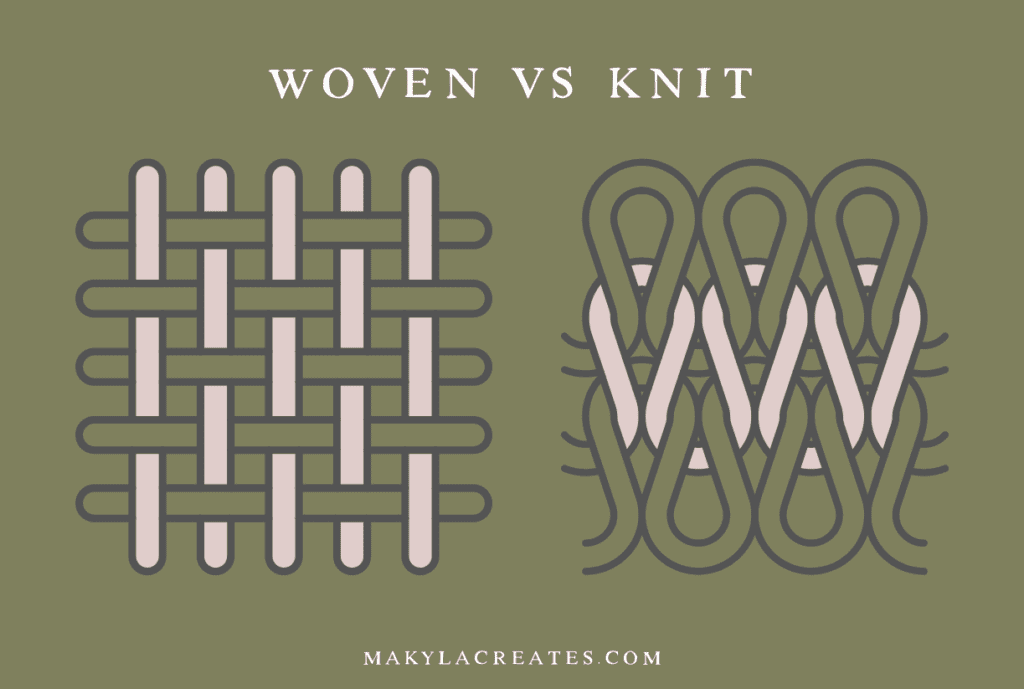
Woven Fabrics
Fibres that are woven together create woven fabrics. There are two types of weaving methods, the warp and weft weave. The warp thread runs along to length of the fabric, also known as the selvedge. The weft thread runs across the width of the fabric, selvedge to selvedge.
This is worth remembering because it can help you cut out woven fabrics correctly. You will often hear the term “cut along the grainline” in sewing if you follow patterns. This guides you to place the grainline along the selvedge or warp threads, which are the stronger fibres.
Along with the direction of the fibres, the fabric yarns can be woven in different styles.
Three Basic Weave Types
- Plain weave – the most straightforward weave style. The warp and weft threads crossover each other at right angles. Each weft thread weaves over a warp thread and then under the following.
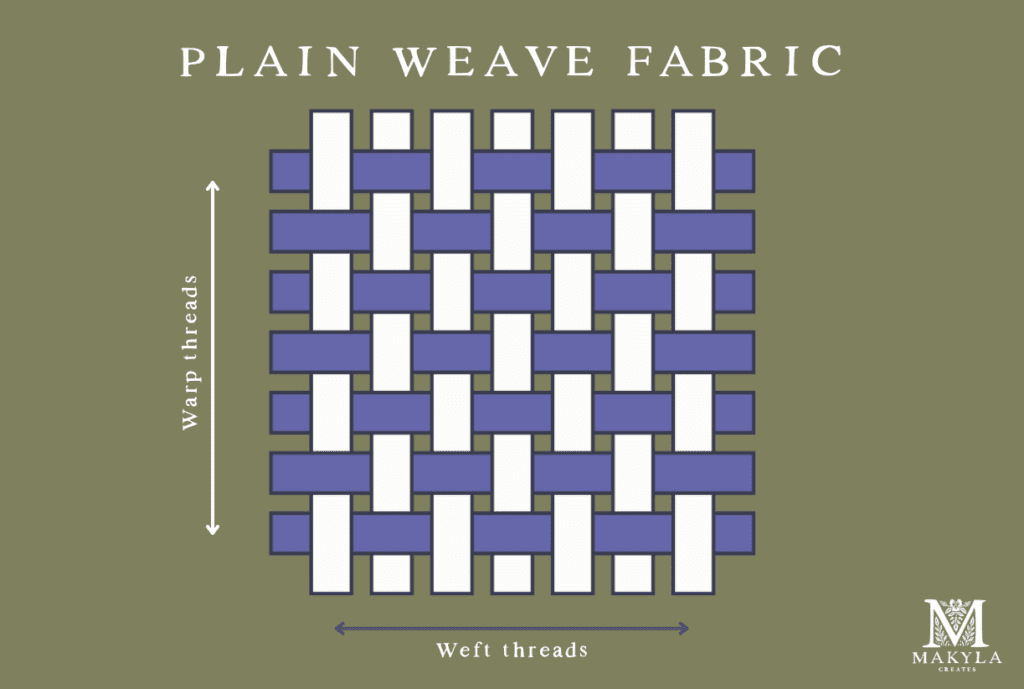
- Satin weave – also called sateen. A satin weave creates a high sheen, whereas a sateen creates a dull sheen. Satin and sateen fabrics are woven together with bigger groups of warp or weft threads going over and under each other.
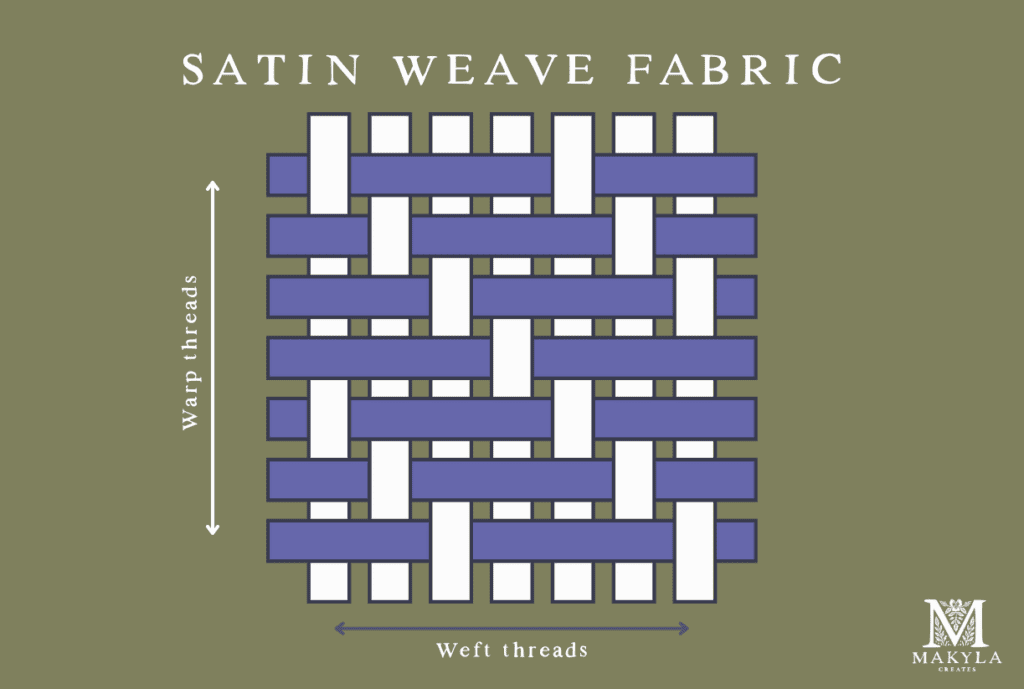
- Twill weave – commonly used for denim construction and wool for suits, a twill weave has a visual diagonal effect. The fibres are woven with the weft yarn crossing over and under two or more warp yarns.
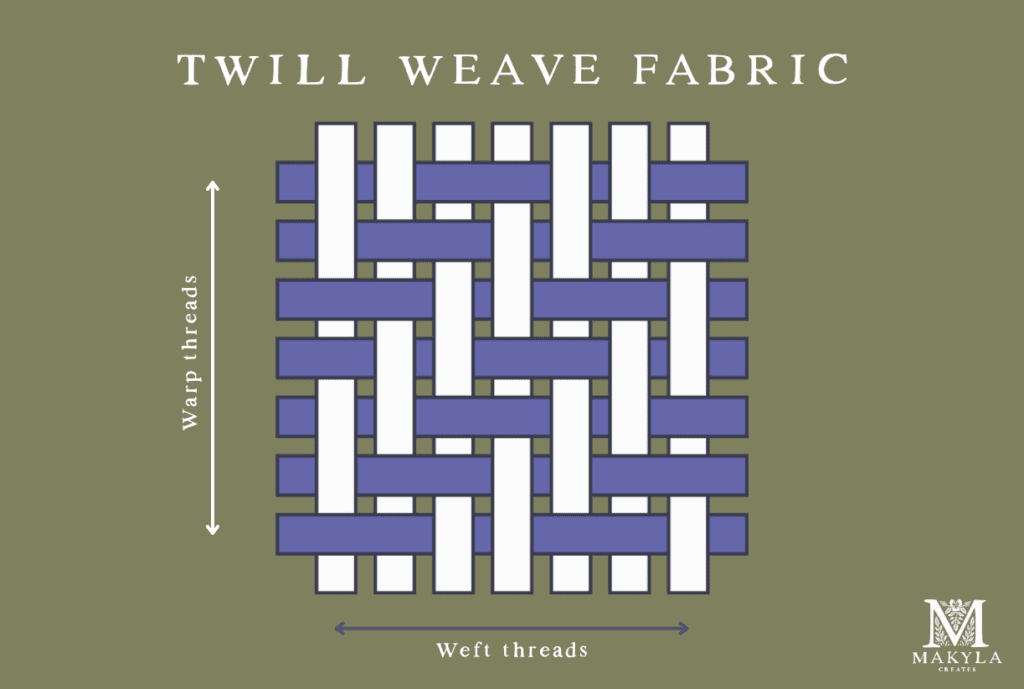
Knitted Fabrics
Unlike woven fabric, knitted fabric is constructed by weaving thread loops together. Knit fabrics can stretch well because the fibres are looped not woven together. Some knitted materials have elastic, or nylon added depending on the fabric type.
Knit fabrics are mass-produced on special power machines to create fine or chunkier styles of fabric. The knit’s thickness depends on the yarns’ ply or thickness and the knitting needle size. A thicker needle makes a larger stitch.
Knit fabrics don’t have a warp and weft. Instead, they have a face side and a reverse side. The face is the garment’s outer or right side because it shows the knitting pattern.
Like woven fabrics, knitted fabrics can have different patterns by knitting the yarns in patterns.
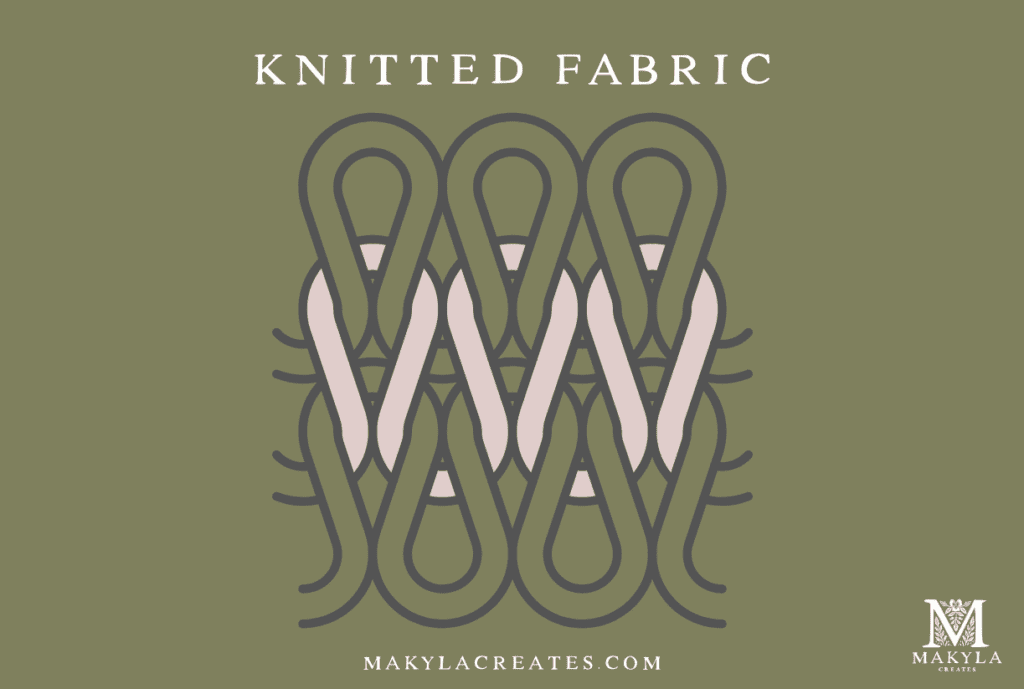
How Knit Fabrics are Constructed
Fully fashioned – refers to hand knitting or using a knitting machine to knit together a garment like a sweater. Sweaters are knit to size by increasing or decreasing stitches, unlike cutting and sewing together pattern pieces.
Cut and sew – is more common in fast fashion for making clothing like t-shirts and sportswear. The knit material is cut and sewn together rather than knitted to size. This method saves on material wastage because pattern pieces can be puzzled together and cut out.
Do you want to learn more about cutting tools? Check out my article on Sewing Cutting Tools for Beginners.
Types Of Fabrics and Materials
Let’s look at a few popular types of fabric you may find on the market, how they are made, their properties, and what garment styles they might be suitable for.
I think it’s good to know that there are broad fabric categories, like cotton, which get made into different fabric types. All have different characteristics, but this post won’t dive deep into those.
1. Cotton
The most common natural fibre, cotton, is a soft fibre from the cotton plant. Cotton goes through a special cleaning process called ginning, which separates the cotton balls from the rest of the plant. These cotton fibres get spun into a yarn and then made into different types of fabrics. Because cotton is incredibly versatile, it can be made into woven and knit fabrics.
Since cotton is so versatile, it can be made into lots of different fabric types. Poplin, denim, corduroy, towelling, muslin, gauze, voile, sateen, jersey, canvas, and calico are common types of cotton fabric.
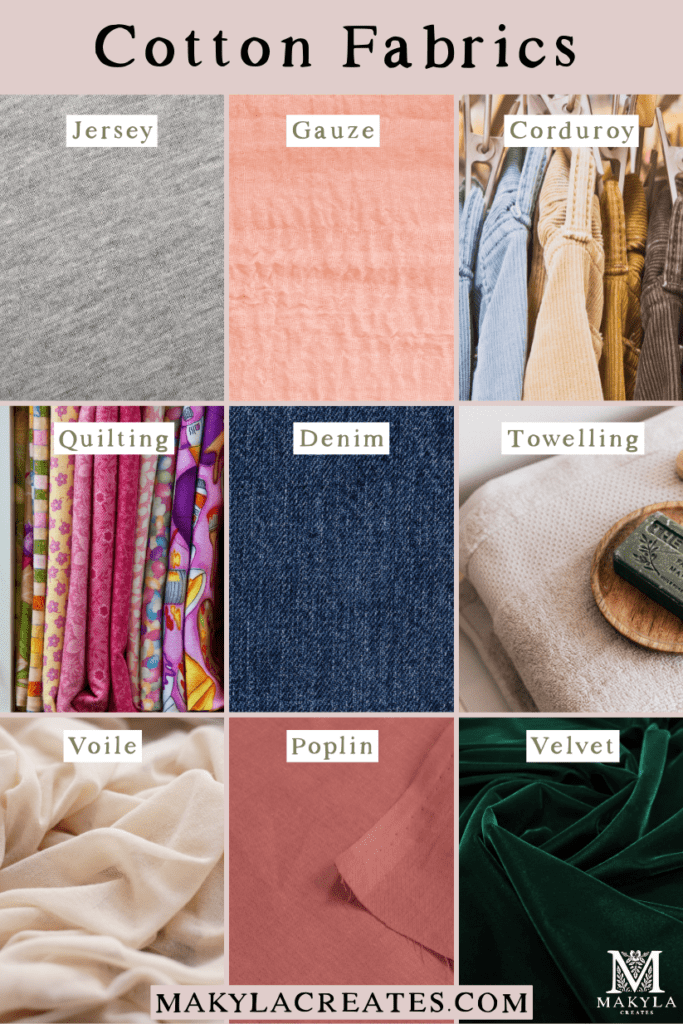
- Cotton poplin, muslin, voile, and sateen are all fantastic for making shirts, blouses, dresses, and shorts because they are lightweight and drape well. Try sewing my Camille top in these lightweight kinds of cotton.
- Denim is great for making jeans, jackets and sometimes shirts, thanks to its durability.
- Corduroy is a fluffy, lined medium-weight fabric that is lovely for making pants or shorts.
- Jersey is a knit fabric that is perfect for making T-shirts or dresses.
- Canvas or calico are thick materials for heavier-duty projects like bags or homewares.
Benefits of cotton fabrics:
- Good level of moisture absorption
- Comfortable
- Trans-seasonal keeping you cold or warm
- Machine washable
- Retains dye colours well if cared for correctly
- Durable fibres make cotton items last longer than other materials
- Lovely fabric to sew and wear
A downside of cotton is that it uses a large amount of water to grow. To create 1 tonne of fibre, cotton needs 25,000 litres of water, whereas polyester only needs 7 litres.
2. Linen
One of the oldest fabrics in the world, linen has been known to be a luxury fabric for centuries. Linen is a lush, natural fabric made from the Flax plant. Flax is incredibly strong, even more so than cotton. It has a beautiful drape and silky look. You may have noticed its current boom in the current fashion industry.
You can make dresses, blouses, shirts, tops, pants, bedsheets, duvets, tote bags and lots more from linen. Try sewing my popular maxi dress tutorial or Chloe dress using linen.
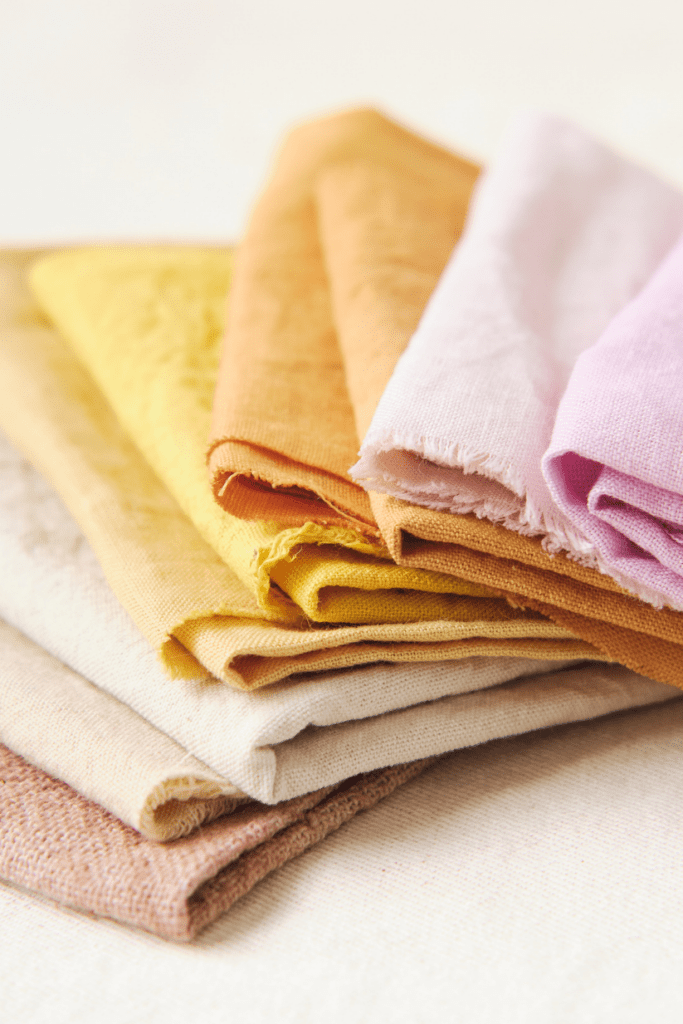
Benefits of linen fabrics:
- Durable, tough fabric
- Absorbent but quick to dry
- Breathable, keeping you cool
- It doesn’t pill and stays lint free
- It gets softer and smoother with age and wears
- Low maintenance
- Lower impact on the environment compared to cotton
A downside of linen is that it creases very quickly, but the fabric’s crinkled, relaxedness makes linen so lovely.
3. Silk
Silk is an expensive, high-end, lush material. The fibres of silk fabric come from the cocoons of silkworms which synthetic fibres can’t replicate. Silk clothing is expensive which is why you might see it in higher-end designer stores. Sewing with silk requires good handling skills as most silk fabrics are lightweight and move a lot. Patience is key!
You can use lightweight silk to make blouses, tops, dresses, shawls, and undergarments like sleepwear and lingerie. Use more structured silks to sew pants, blazers, or dresses.
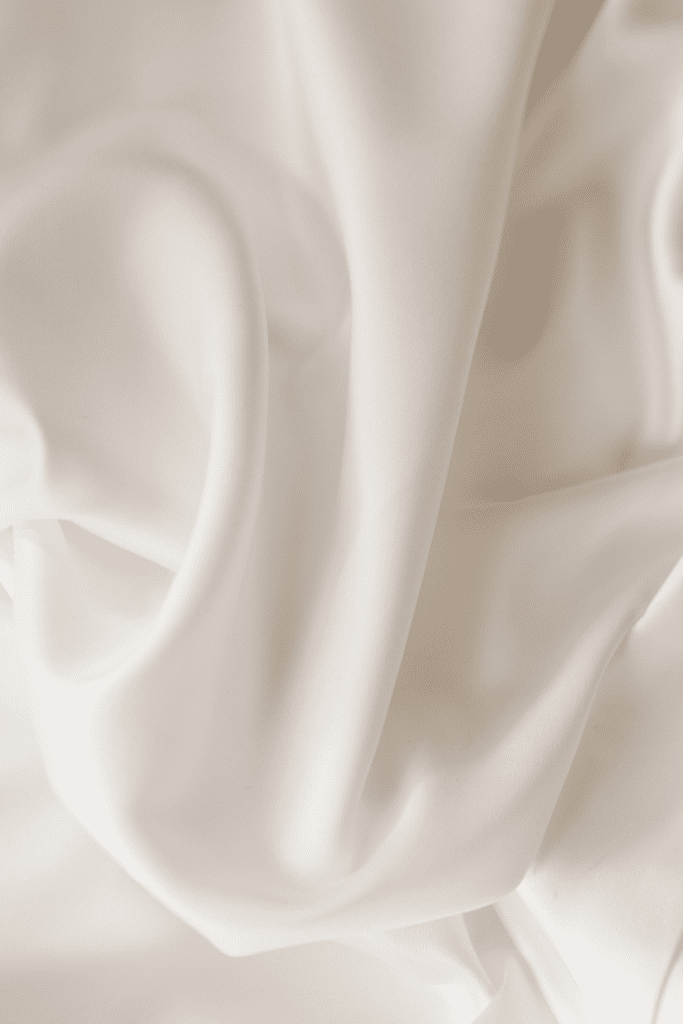
Benefits of silk fabrics:
- Soft, smooth fabric
- Pure silk material lasts longer than a mixed blend making it highly durable.
- Stronger fibres than wool or cotton
- It has high absorption, so it takes dyes well
- Comfortable to wear in cool and warm weather
Sadly, silk is made from Bombyx moths that are killed before they break through their cocoons. Peace silk is an alternative to traditional silk, which lets the moth break through its cocoon before harvesting.
4. Wool
This natural fibre is made from animal hair. The wool fibres come from sheep, alpacas, goats, and llamas. The wool may be softer or higher quality, depending on the breed. Merino is fine luxury wool that comes from the merino sheep.
You will see wool used to make knitted jumpers, sweaters, and cardigans. It can also be made into woven fabrics like tweed, tartans, houndstooth, crepe, or flannel. These fabrics are used to make suits, dresses, or blazers. Coco Chanel’s classic jacket is made from wool tweed.

Benefits of wool fabrics:
- Strong fibres
- Repels water away, keeping you warm
- Is antibacterial helping keep odours at bay
- It has a high resistance to heat so that it won’t catch alight as quickly as other materials
Some wool garments can be itchy depending on the type of fabric. Wool materials like merino and cashmere are soft and buttery. Tweeds, houndstooth or plaid fabrics can be scratchy.
5. Polyester
Polyester has been the most popular synthetic fabric on the market since the 1950s. It is made from oil or plastic and is a low-cost material, making it popular in fast fashion.
PET is a type of polyester fabric that is made from recycled plastic bottles or packaging. Many companies are greenwashing PET into being a “sustainable fibre” because it uses recycled materials.
Like cotton, polyester has many different types of forms. It can be blended with natural fibres to help add durability and strength. For example, wool polyester blend sweaters are commonly found on the market today.
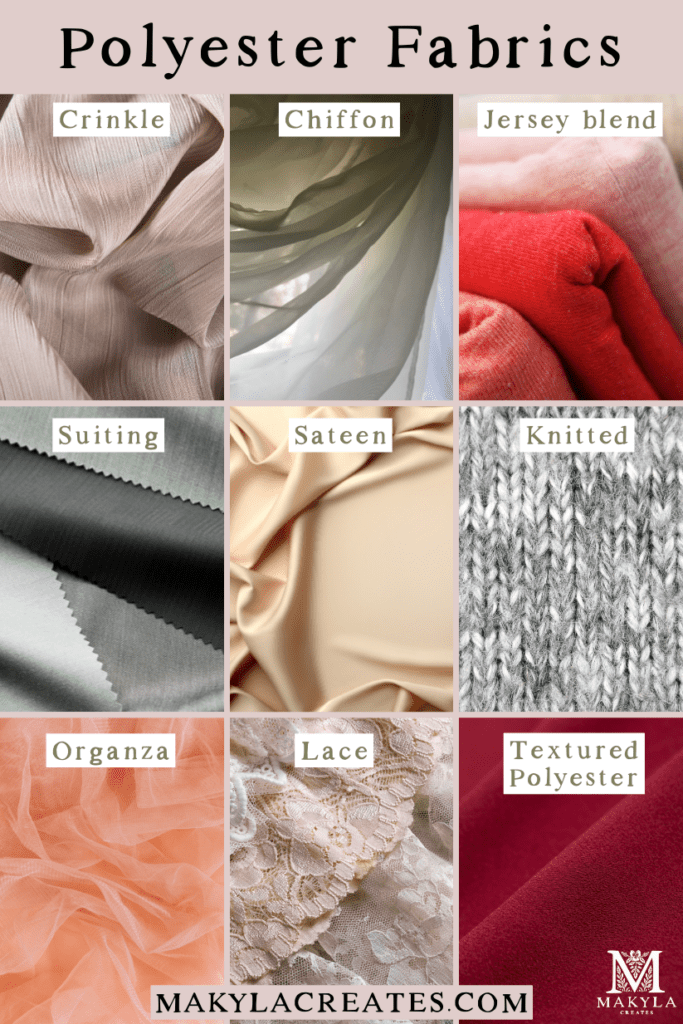
Chiffon, crepe, crepe de chine, PET, and lace are common types of polyester fabric. It is versatile, so it can be made into lots of fabrics. Since it’s so cheap to make, you will notice that other sewing materials, like zip tapes and threads, are made from polyester.
Polyester fabrics can be made into any sort of clothing like sportswear, lingerie, swimwear, baby clothing, suits, coats, and even shoes. Homewares can also be made from polyester fabrics like furnishings, cushions, sheets and towels.
Benefits of polyester fabrics:
- It’s durable thanks to its long artificial fibres
- Moisture-resistant polyester wicks away water
- It holds its shape better than cotton and linens
- Blended with natural fibres, it extends garment longevity
- Stain resistant
- Less likely to shrink
- Cheap and affordable to buy
There are many downsides to polyester because it is chemically made from materials like oil which are non-renewable. Wearing polyester can be bad for our skin and body health. The material doesn’t breathe like natural ones and can cause sweating and excretion of chemicals from the fibres. It also has a rough or cheap feeling compared to other materials.
6. Rayon
Rayon or viscose rayon is a lovely soft fabric from wood pulp. It isn’t classed as a natural fibre because it needs to be converted into a fibre artificially.
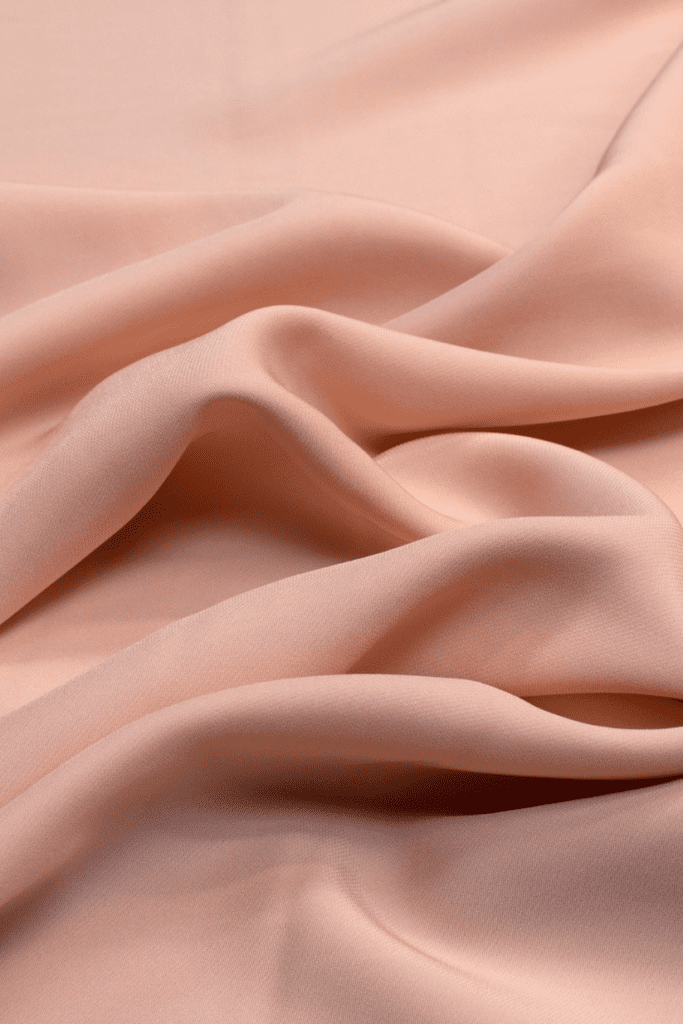
Viscose rayon is now being replaced with more sustainable options that are better for the environment.
- Tencel® or lyocell, are kinds of rayon made from sustainably farmed eucalyptus trees.
- Seasell® is a viscose rayon made from sustainably sourced seaweed.
- Cupro is rayon made from cotton linter, a by-product of cotton production.
- Modal® is made from pest-resistant beech trees. The wood is not transported long distances, and the processing of this fabric is said to be carbon neutral.
Use rayon to make lightweight garments like camisoles, dresses, shirts, blouses, loose-fitting pants, shawls, pyjamas, and skirts. I love sewing this blouse using Tencel or cupro rayon fabrics because they come out soft and silky. I also use rayon to make bias skirts thanks to its lovely drape.
Benefits of rayon:
- Cheaper alternative to silk
- A soft, buttery fabric which drapes well
- Comfortable to wear
- Breathable making it perfect for lightweight summer garments
- Many sustainable options to choose from
Rayon isn’t as durable as silk or other fabrics, but it does have a lovely drape and silkiness that makes it appealing to use in sewing. Prewashing rayon is a must to reduce shrinkage after sewing something.
7. Hemp
A natural fibre, hemp is made from the hemp plant. Hemp is a great plant that doesn’t require pesticides and grows quickly. It is super strong, making it a good fabric for bags, rut sacks, and heavy-duty clothing items like pants or jackets.
Hemp can be considered a rougher, linen-like fabric, it can be made into delicate laces or silky fabrics.
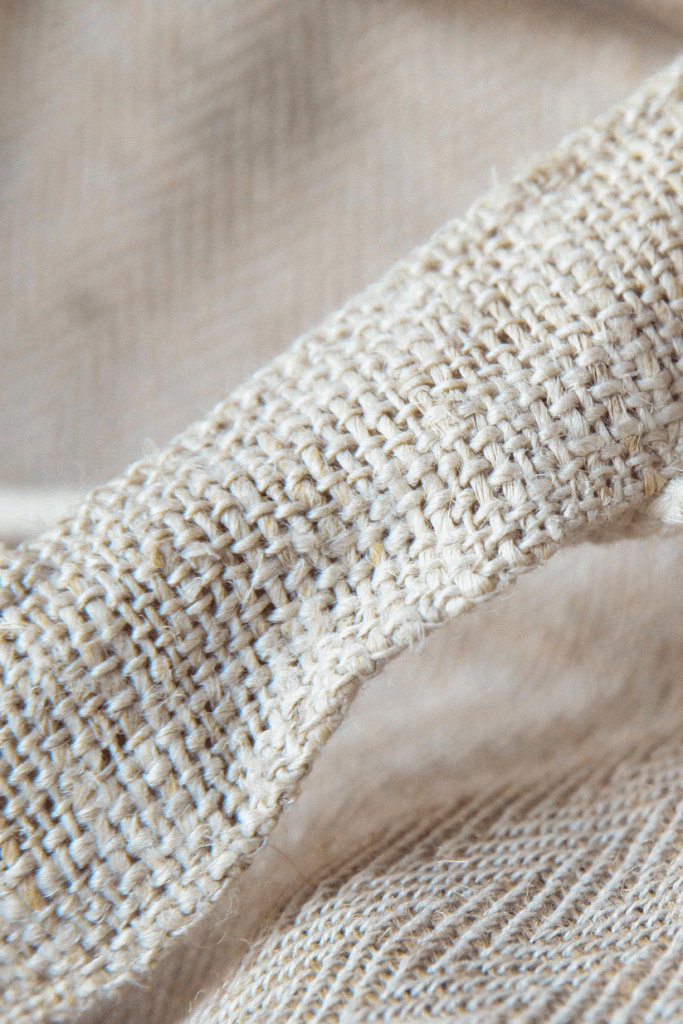
Benefits of hemp:
- Extremely durable
- Resists decay and mould
- Good absorbency
- Softer when blended with cotton or other fibres
Hemp fabric can be harder to find compared to linen.
To Sum Up
Hopefully, this beginner’s guide has given you a better understanding of the wide variety of fabric types available on the market and how you can apply them to your sewing projects.
Learning the properties of materials can help you make more informed sewing decisions. I also think it’s important to know where each fabric comes from, especially if you want to use sewing to reduce your environmental footprint.
Very informative. Thanks, I enjoyed reading your presentation. I used to sew when young, but that’s been several decades back. I was curious about two older popular fabrics of the 50’s & 60’s that we sewed with. Don’t know what they were made from, but they were used in dresses & blouses. One was called whipped cream and the other was seersucker. I didn’t see them here. Are they extinct now?
Hi Monte, I’m so glad you enjoyed this post. There is still seersucker which I have used a few times – it is often made from cotton or polyester fibres. I haven’t heard of whipped cream before but it sounds interesting! Thnks for sharing 🙂